2017 Farm Inventions competition: Simple category
This year’s simple category in the Farm Inventions competition shows workshop ingenuity at its best.
They’re often simple in nature, but also demonstrate farmers’ knack for finding nifty solutions to everyday problems.
Our highlights include a quad bike security system, a bale grab with integrated fuel tank and a smart-looking fertiliser trailer.
William Barton’s quad bike security system
Farmers have battled for years to come up with a failsafe method of preventing petty criminals from pilfering their ATV.
But at last it looks as if Nottinghamshire farmer William Barton has cracked it.
By using a frame attached to a remote-controlled winch, he hoists his bike up into the rafters of the shed, leaving even the most determined of light-fingered visitors scratching their heads.
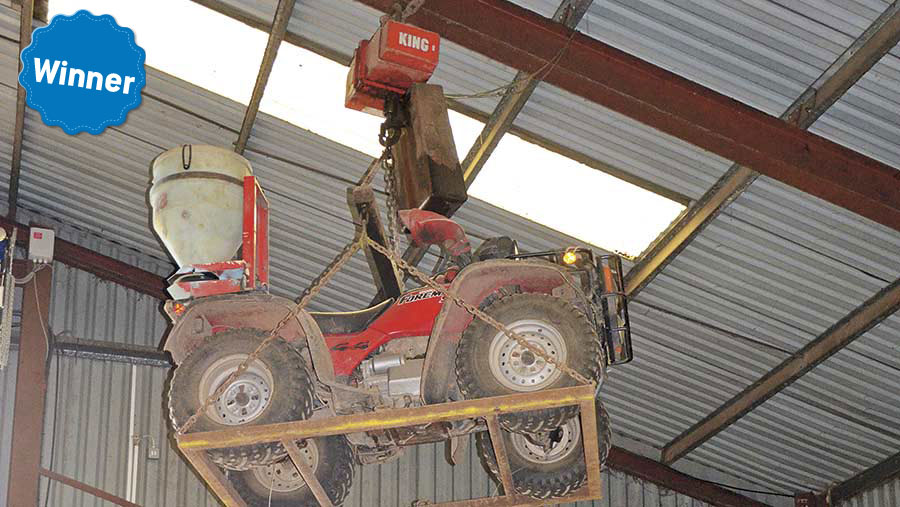
With the remote control tucked away safely in the farmhouse, there is no easy way of getting it down. The framework was simple and cheap to knock up out of an angle iron lying around the workshop.
See also: Five 18V cordless grinders on test
Henry Bodman’s bale grab fuel tank
Wiltshire contractors J&M Bodman have huge amounts of big-bale straw to shift in the summer.
But the small fuel tank on their Manitou MLT 741 telehandler means they are usually out of juice by mid-afternoon. As they are often miles from base and with no suitable places to store fuel on board, Henry Bodman decided to come up with a solution.
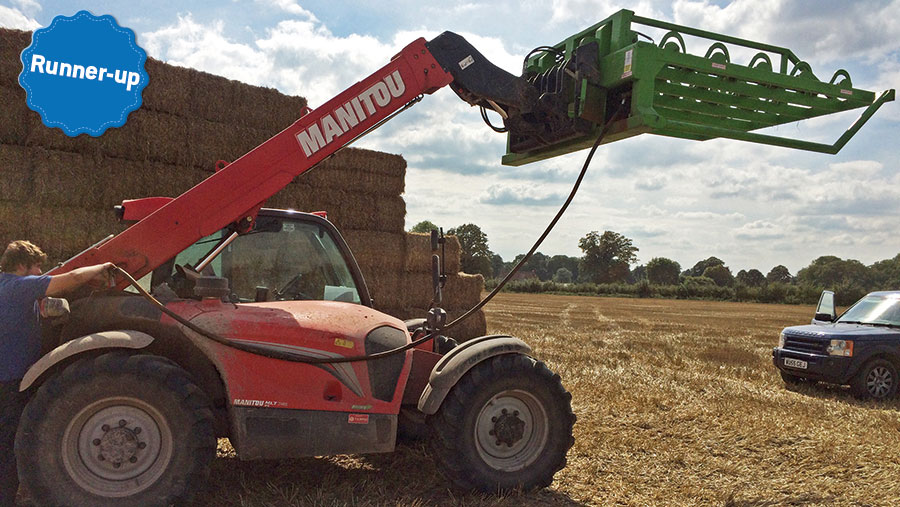
That came in the form of a 110-litre fuel tank built into the back frame of the bale grab.
He added a hose and dispensing gun, which are stored in the bottom rail of the grab, and when he needs to refill he raises the grab, using gravity to let the fuel flow into the telehandler’s tank.
The grab is also fitted with replacement hydraulic hoses and a spare grab ram to minimise any down time. Mr Bodman added all of the modifications last winter and says they made a big difference to this summer’s operations.
Simon Warburton’s telehandler headstock
After upgrading his telehandler to a JCB 525.60, Simon Warburton found he was left with a stack of loader attachments that didn’t fit the carriage on his new machine.
JCB doesn’t offer the headstock option he was after, so rather than building or buying an adaptor plate, he decided to remove the standard Q-Fit carriage and make his own Euro-style attachment system that would fit directly on to the JCB’s swan neck.
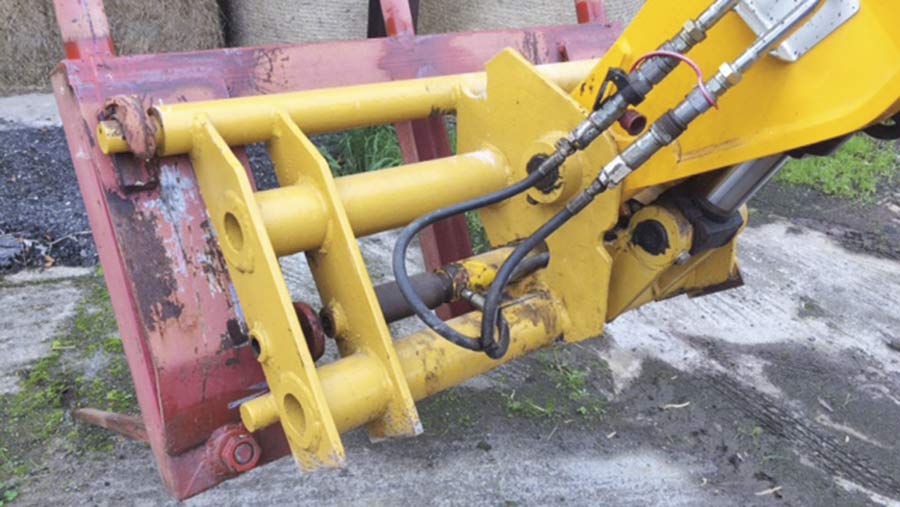
The build relied mainly on plate steel that sits along two 1in-thick lengths of heavy-duty tubing.
He managed to fit hydraulic locking pins, too, and had all the steel in stock already, so the build cost him less than £200.
Jeff Bradshaw’s fertiliser trailer
Jeff Bradshaw has used a fertiliser spreader crane for years, but with distances to travel between blocks of land increasing and fewer people around to help ferry trailers, he decided to make a trailer he could tow behind the spreader.
Starting with a second-hand 10t Griffiths trailer, he extended the drawbar and fitted a swan neck so it could be picked up with the spreader in situ.
To help keep the bags in place he fitted side and rear rails made out of scaffold poles and fitted a roll-up sheet to keep them dry.
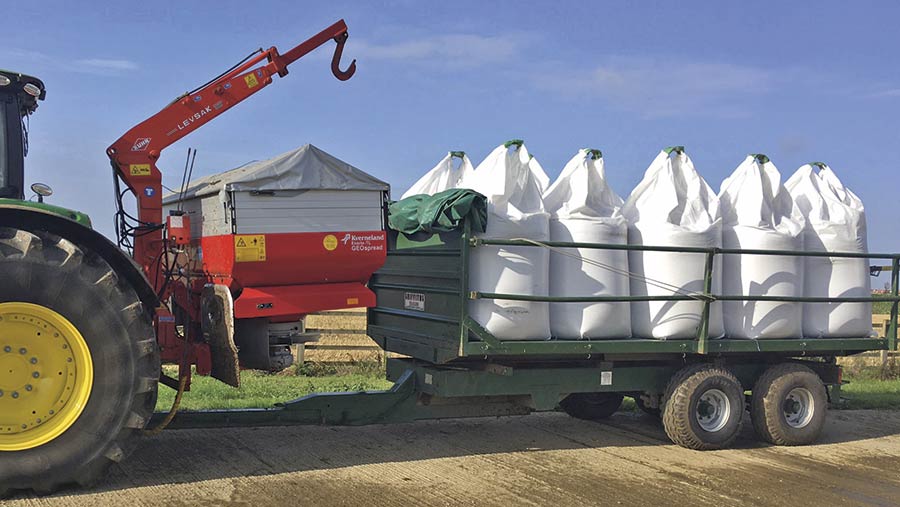
Once in the field, he drops the trailer off and loads the spreader from the side.
Fully loaded, the trailer can hold 8-10t of fertiliser and he can get 2-3t in the spreader. Typically he will do three to four full loads a day without relying on another driver and tractor to bring bags to him.
Andrew Metson’s wheel-track eradicator
Planting at a consistent depth is key for good establishment and when Andrew Metson noticed tractor wheel marks still visible after drilling, he set about making some eradicators for his 6m Horsch Sprinter.
He was keen not to affect the turning circle or workings of the drill, so he found the best location for the tines was tight behind the tractor wheels, rather than sat on the drill itself.
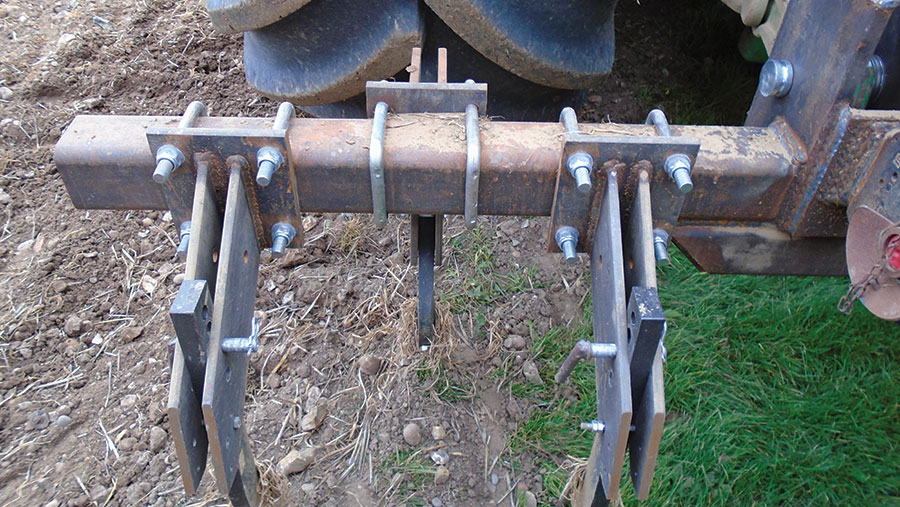
The box-section-built toolbar sits on the links arms of the tractor, with three tines – one central leading tine and two following either side – running immediately behind each wheel.
The drill now connects to the tractor via a set of dummy quick-release arm hooks that are welded on to the toolbar.
Shear-bolts protect the tines from heavy thumps and the leg units can be shunted along the bar to suit different tyre sizes.
Alan Hughes’s staple puller
To help take the hassle out of removing staples from fence posts, Alan Hughes built this handy pulling tool.
Its design is centred around a pair of wedge-shaped spikes that the operator pokes behind the wire trapped by the staple.
By pulling down on a handle the tool’s jaws close, forcing the wedges down and popping the staple out.
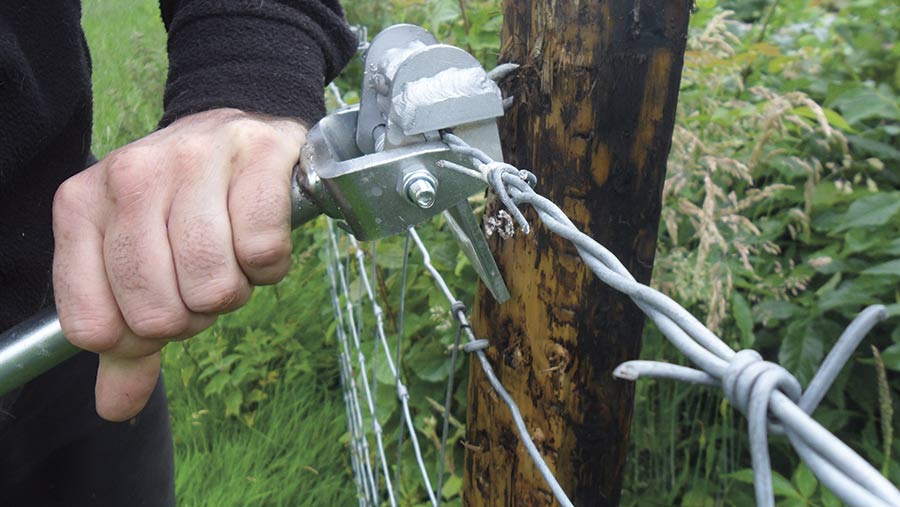
According to Mr Hughes, its gentle operation means it doesn’t damage the wire. He has also had it zinc coated to keep the rust at bay.
David Powell’s calf catcher
The perilous job of taking a newborn calf away from its mother for feeding, tagging or injections led seasoned inventor David Powell to build his own cowboy-style calf catching device.
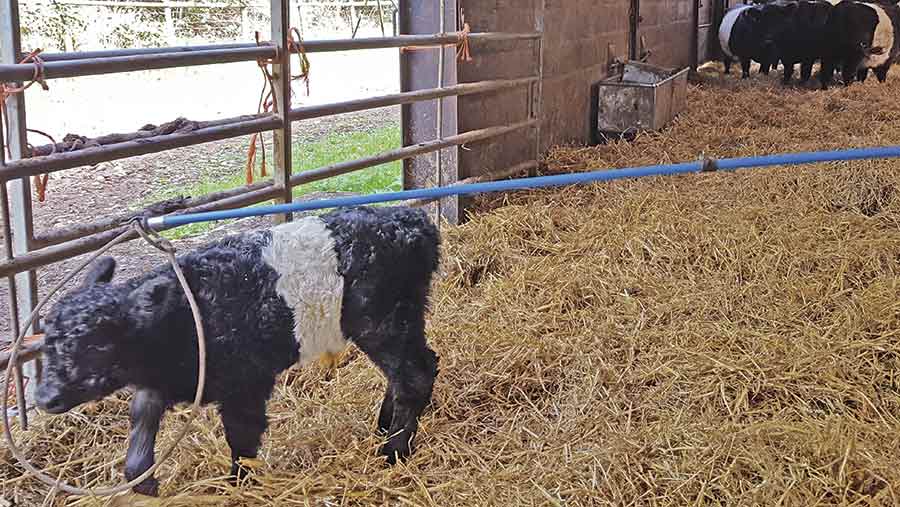
The telescopic pole – made from blue plastic pipe – reaches to 25ft and has a rope lasso threaded through its centre to hook around the calf’s neck, which means he can stand safely outside the pen.
Stanley Roberts’ hedgecutter brace
Serial inventor Stanley Roberts from Colwyn Bay built a simple bracket system for mounting a hedgecutter to the tractor’s drawbar.
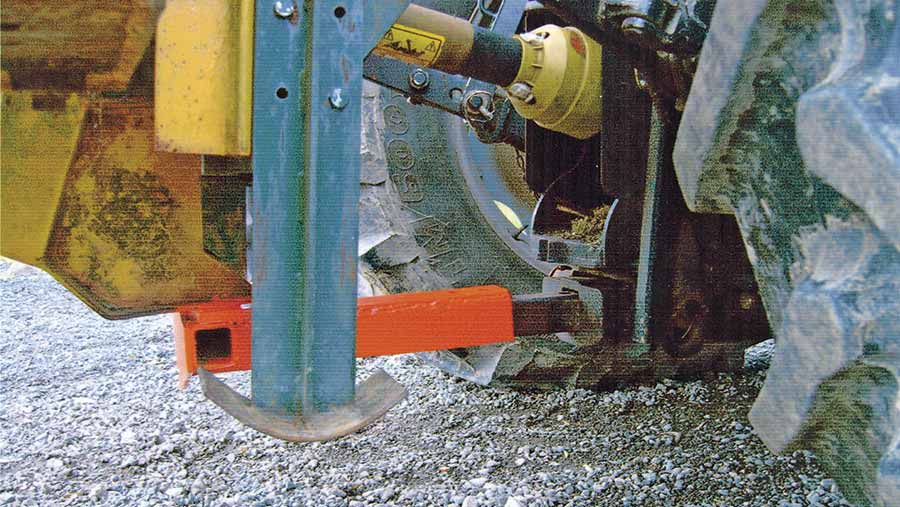
The hedgecutter is lifted up on the three-point linkage in the normal manner, but to save fitting a stabilising subframe to take most of the weight, Mr Roberts has designed a system that slide sheath-like over the drawbar.
Once in place, the hedgecutter can be lowered onto the bracing unit and the two can be bolted together to hold it in position.
Llŷr Jones’ swath compressor
Nineteen-year-old Llŷr Jones built this swath compressor as a project for his land-based engineering course at Glynllifon College.
He came up with the idea because while baling at his family farm on Anglesey, he found silage would wrap around the prop shaft until it eventually ground the tractor to a halt.
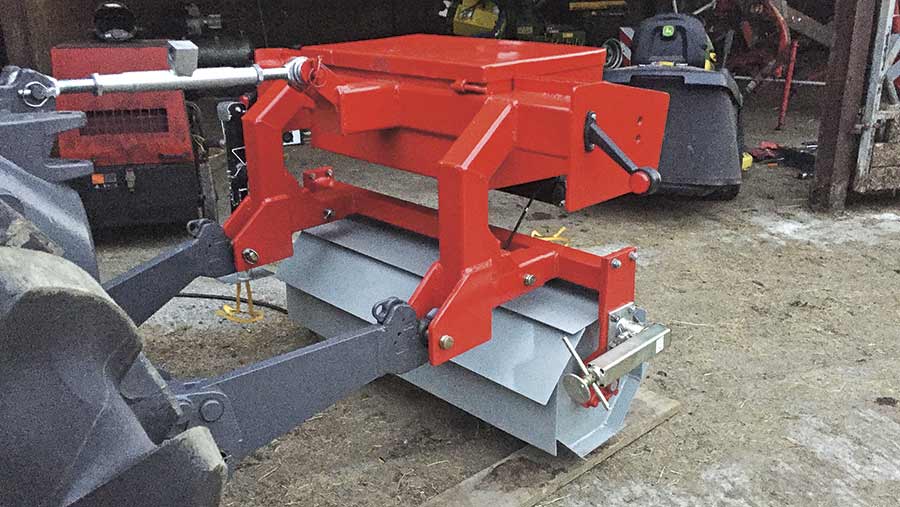
His solution was to build a frame to hang off the tractor’s front linkage with the roller suspended underneath. He also made space for a toolbox and 10 50kg wafer weights on the top.
The roller itself was made out of eight sections of flat steel sheet welded around octagonal end plates, with overhangs to bite into the swath and help it turn. This spins on bearings and carriers taken from a scrap power harrow.
There’s a storage jack fitted on each side for when the whole unit needs to be removed, but he’s also designed it so that the roller can be separated, leaving the toolbox and weights in place.
Alan Hughes’ cow feeding stand
TB continues to blight UK livestock farms and a large source of contamination comes from badgers getting at cattle mineral feeds.
To solve this problem, Alan Hughes has built a novel feeding stand that’s strong enough to cope with a cow rubbing up against it, but is also high enough to keep the badgers away from the grub.
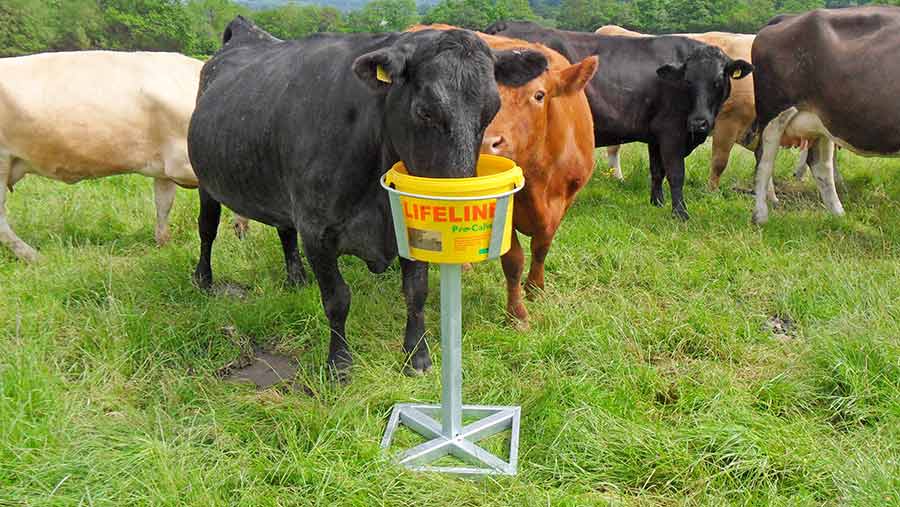
The secret to its stability is a spiked auger below the base that’s screwed into the ground, anchoring it securely in place. At the top there’s a frame that can accommodate mineral buckets from 15-35kg.
As with his fencing tool, it’s been treated to a dip in the galvanising tank.
David Rowe’s swath roller
Getting material to feed into the baler can be one of harvest’s great frustrations, and it led to David Rowe knocking up an hour-glass-shaped cage roller to even things out in front of the tractor.
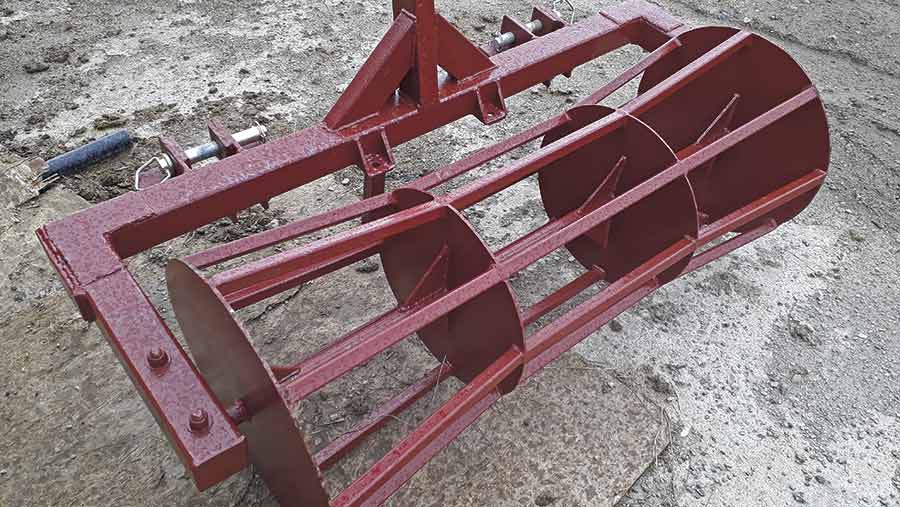
The build took just three days and made use of the farm’s stash of workshop metal to form the combination of bars, circular plates and box-section frame.
Bearings were sourced online and it got a coat of red oxide before its trial run this summer.
Bill Lowe’s bunded oil store
To keep the Farm Assurance inspectors happy, Cheshire-based Bill Lowe cut up a redundant single-skin diesel tank and built a platform to house all his oil drums.
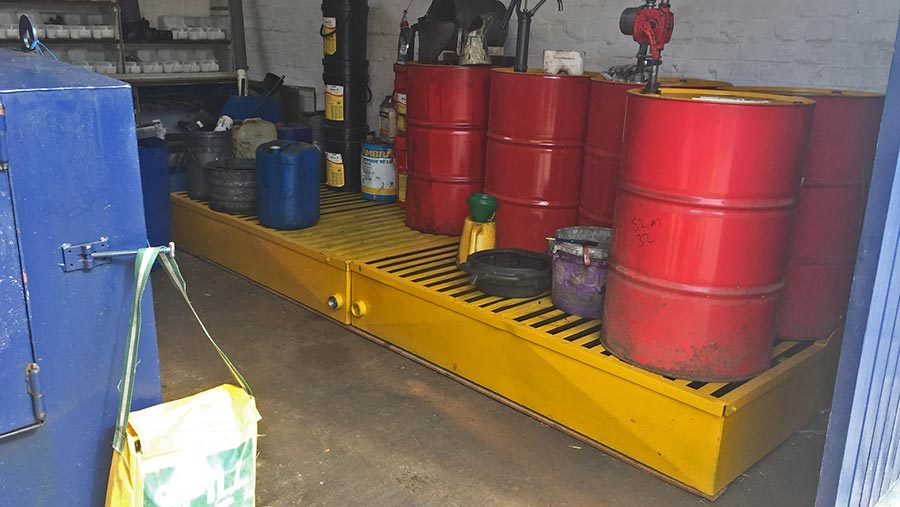
The old tank was sliced in half and he welded up a grid on the top to form a drip-through floor for the containers. Oil spills are now caught in the bunded area below the grid rather than covering the fuel store floor.
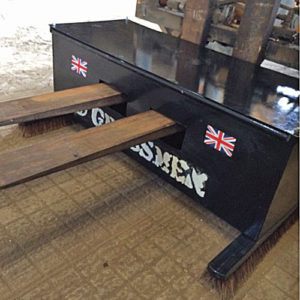
Ryan Ackers’s yard sweeper
Agriculture student Ryan Ackers designed and built a simple yard and grain sweeping attachment for the telehandler.
Central to the construction is an old water trough, through which he sliced slots wide enough to accommodate the loader’s pallet forks.
He then attached a load of regular yard broom heads on the bottom, but it’s also handy for doubling-up as a front weight block on the loader tractor.
Thomas Faith’s lawnmower scraper
When his old scraper tractor was due for retirement, Northern Irish farmer Thomas Faith decided to find a machine that could tuck into those harder-to-reach corners of the yard.
He spotted a Kubota ride-on lawnmower being sold by a local gardening firm and reckoned its rear-wheel steering would give him the manoeuvrability he needed.
After buying it he took it to the workshop and set about fixing a scraper to the front in place of the cutting deck.
This made use of the existing hydraulics for raising and lowering.
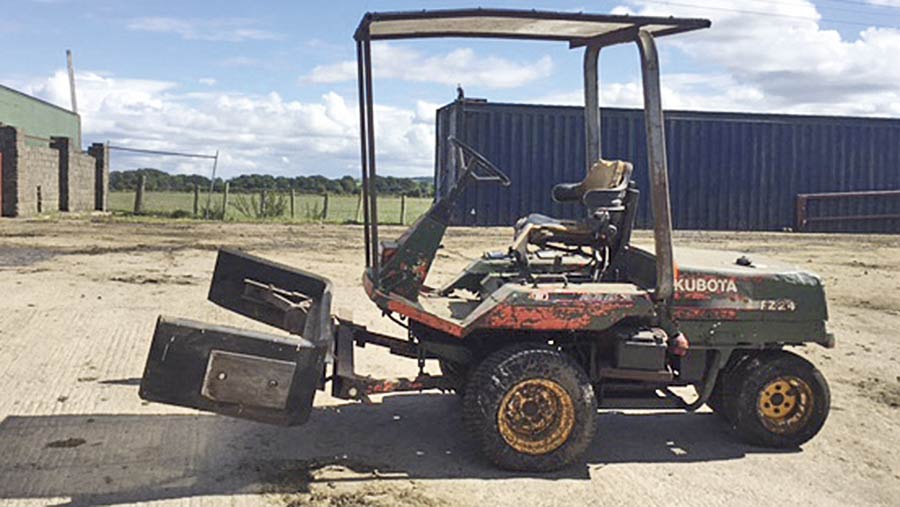
The only bought-in parts were the rubber skirt for the scraper and a plastic sheet canopy to keep the driver dry when the weather turns.
Paul McLean’s fertiliser spreader trolley
In a bid to make it easier to hook up his fertiliser spreader and shunt it around the storage shed, Paul McLean built this handy trolley.
Rather than just attach the wheels to the bottom of the spreader, he decided to extend the box-section frame by 500mm, to save faffing with link arm turnbuckles ready for taller crops.
The decent-sized castors also make it easy to bowl around.
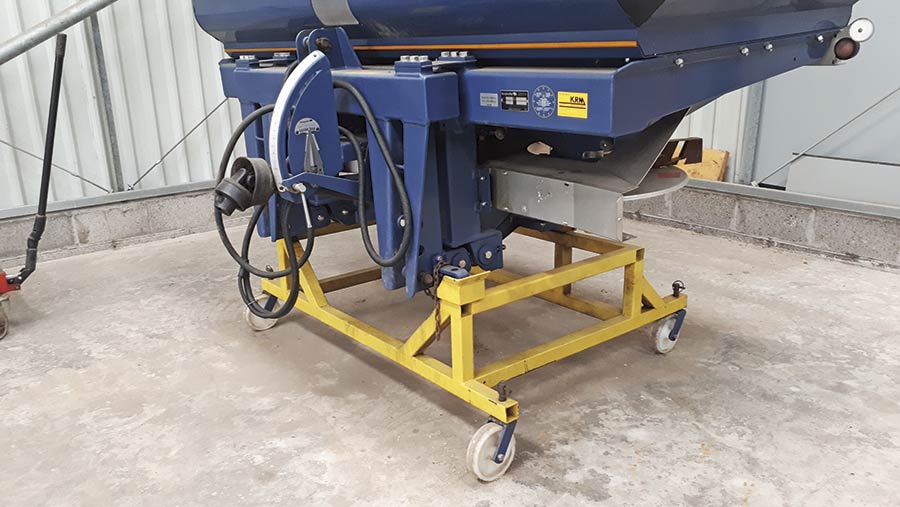
As well as being considerably safer than stacking it on pallets, the spreader can be tucked away neatly and saves a lot of time when hooking up. The project took an afternoon to complete.
John Lord’s gate storage frame
Gates and hurdles are a pain to store in a tidy fashion, so Grantham farmer John Lord decided to knock up some simple frames to hang them on.
Each frame holds about 40 hurdles, which are slid on to a pair of rails on each side. Removable pins are then slotted into the end of each rail to keep them in pace.
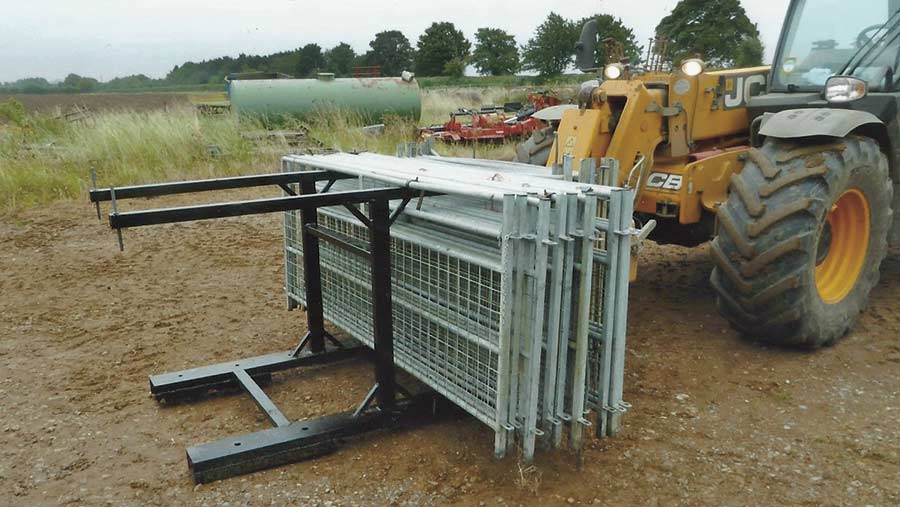
At the base of the frame, he fitted channels for pallet forks to slide into so they can be moved around the farm. The frames were made entirely out of recycled farm steel.
Tom Carrigan’s mobile wrapper
Undercover storage is usually at a premium come the end of the summer, so Tom Carrigan, designed a wrapping system that would allow him to stash bales safely outside.
To keep the elements at bay, he used two wrapping dispensers from a standard bale wrapper and mounted them on a frame to fit the farm’s pivot-steer Matbro loader.
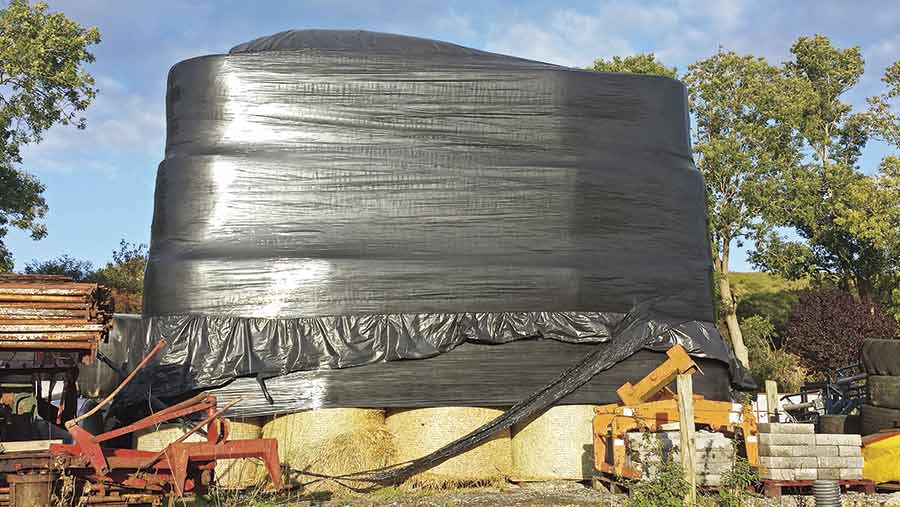
The dispensers are fixed so they overlap to leave nothing uncovered, starting at the bottom of the stack and working up so that the next layer covers the previous one.
In the past, Mr Carrigan has also wrapped machinery in the same way to keep it clean on motorway journeys.
Thomas Faith’s hydraulic cattle gates
Thomas Faith uses a 10-point milking parlour on his Northern Ireland farm, which had vacuum entry and exit gates, along with vacuum-powered bars to hold the cows in place when milking.
However, knowing that hydraulic power had more grunt to offer than the old vacuum system, he was keen to upgrade.
Doing away with the vacuum system also had the added benefit of stopping exhaust fumes wafting round the parlour.
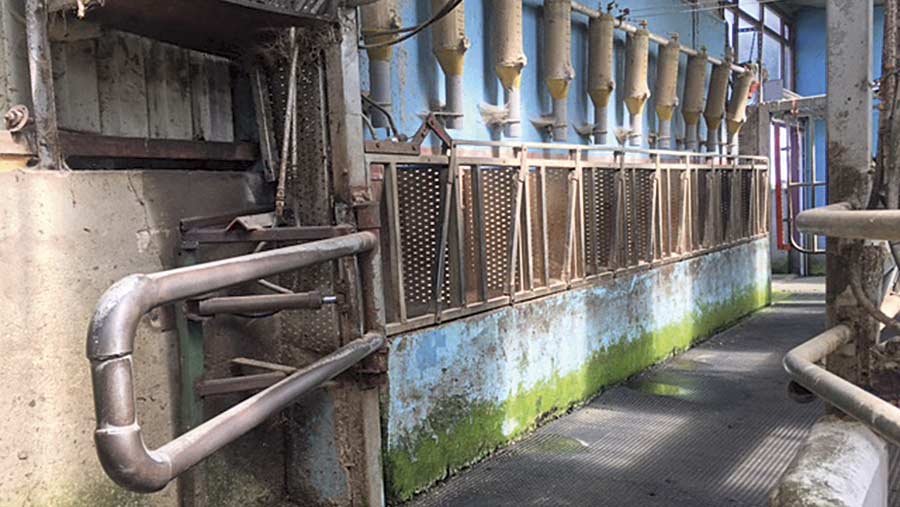
After picking up a second-hand hydraulic power pack from an ex-military base near to his farm in Ballykelly, Northern Ireland, he set about the conversion.
Four large rams for main gates were pinched from a manure grab lying around the farm, while the two smaller headstock rams were picked up from a local factory clear-out sale.
Albert O’Neill’s cow mover
Shifting downer cows usually requires significant manpower, but Albert O’Neill of County Tyrone has come up with an attachment that slots on to the back of the telehandler bucket.
It has the two poles that extend vertically to a horizontal winch running the width of the bucket. Two lengths of rope then drop down and attach to the cow’s feet.
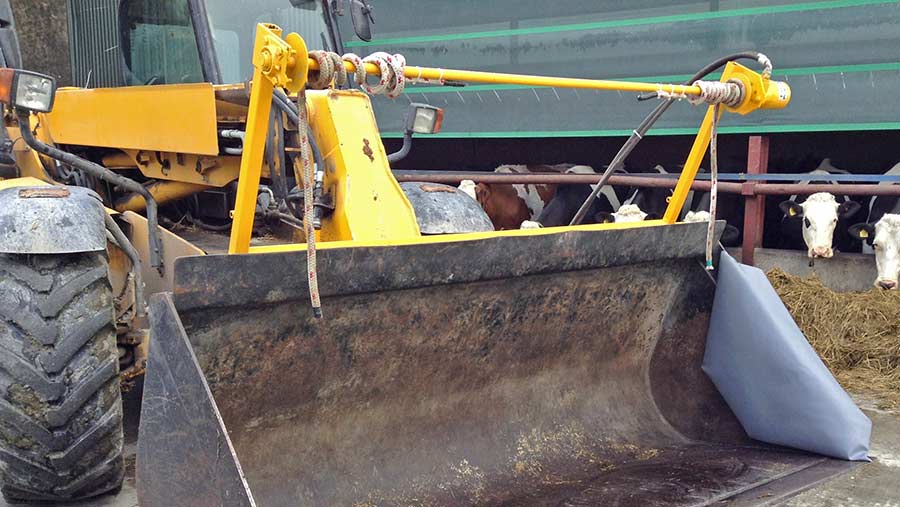
The low-speed, high-torque winch connects to the telehandler’s hydraulic circuit and, as it winds the ropes in to bring the cow closer, the bucket is slowly crowded to complete the loading process.
Mr O’Neill – who has 200 Holstein cross Montbeliarde cows – has also developed a removable magnetic pillow for the cow’s head, which snaps over either side of the telehandler bucket – depending on the animal’s position.
It cost him £400 to develop and mounts on a standard Q-Fit JCB headstock.

Mike Sherwood’s bale wrapper cradle grips
Fed up with bales slipping through his wrapper pickup arm when bouncing across fields, East Sussex farmer Mike Sherwood decided to make some modifications.
His triangular pickup arm grippers are made out of flat steel and have a long leading edge to make sure they don’t snag the net wrap on the way in.
Once the bale is fully seated in the pickup, the points grip the outer edge and prevent it sliding out.
Since the modification, his father – who handles wrapping duties – can charge around with one bale on the turntable and one in the pickup, allowing him to stockpile the crop into trailer-sized loads.
To cope better with odd-shaped and slumped bales, Mr Sherwood also welded a 30cm cranked extension on the outer pickup arm.
Recently, he has seen similar modifications on off-the-shelf wrappers, but reckons he definitely beat them to it.
Matt Kidner’s transport box trolley
Storage is at premium at Matt Kidner’s small family farm, so he has to get inventive to make sure all of his kit can be slotted into the space available.
Even the old transport box isn’t left to rot in the elements thanks to an old carpet shop trolley he modified to store it on.
This allows him to tuck the box away in the odd spare corner than couldn’t be accessed by a tractor.
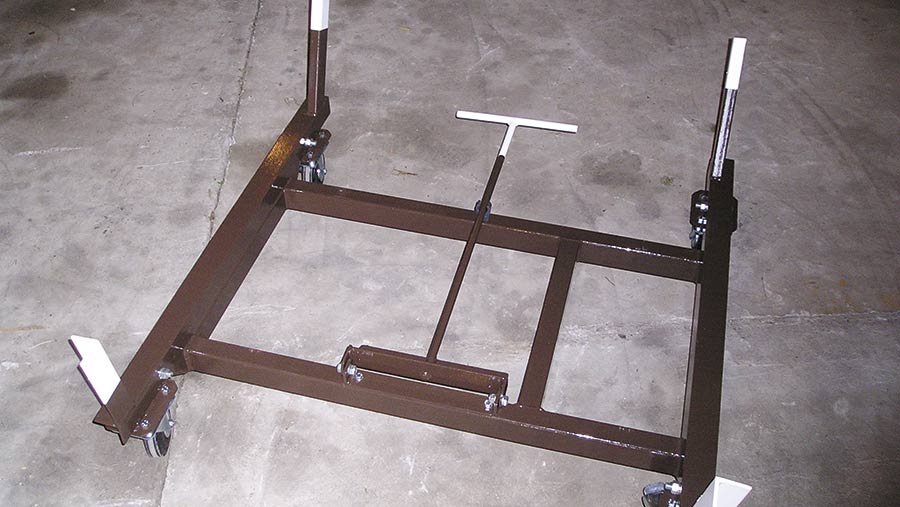
He started by removing the upright frame from the freebie trolley and added a diagonal brace to the basic trolley frame.
He then welded in box-section guides to help the transport slide into the correct place when dropped off the tractor.
Finishing touches included replacing the original castors with better-quality braked units and adding a folding T-handle to make it easier to pull around. When not in use this folds down out of the way.
John Samsome’s implement shifter
Rather than shell out for an off-the-shelf telehandler-mounted implement shifter, John Sansome decided to put one together in the farm workshop.
To keep the design simple and make it ultra-fast to pick items up, he fabricated a hook to slot under the top link pin and large bumper plates to brace against the lower link pins.
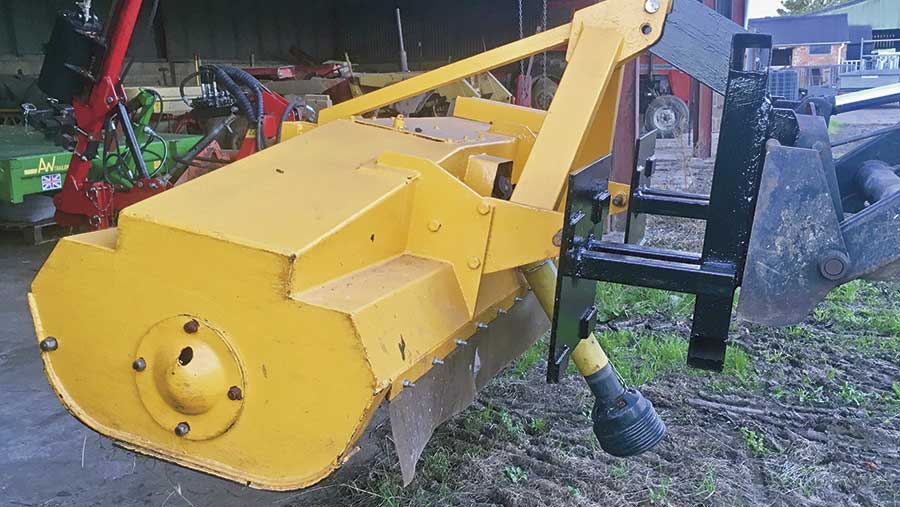
Other than a pair of loader brackets, the tool was built out of recycled steel already on the farm and it took about 10 hours to complete.
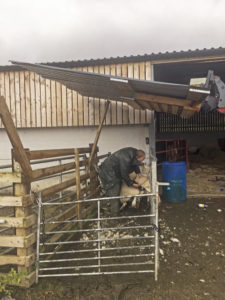
Rod Smith’s portable shelter
Rod Smith’s portable shed roof helps knock off the worst of Keswick’s weather when outside jobs have to be done.
The starting point was a good-quality used pallet that was beefed up by adding a few extra boards.
Box-profile sheeting was then screwed to the pallet to provide a 3m square canopy.
This is then lifted over sheep- and cattle-handling areas with the tractor loader meaning they can use the electric clippers when it is raining.
It was also used for repairing a gap in one of the farm’s stone walls when the rain was lashing down.

